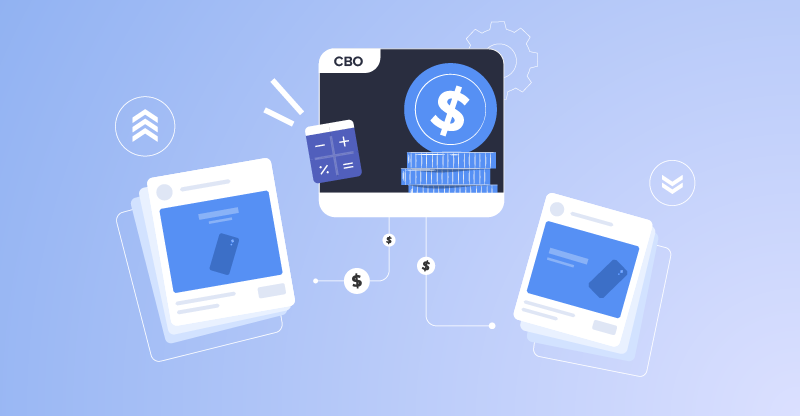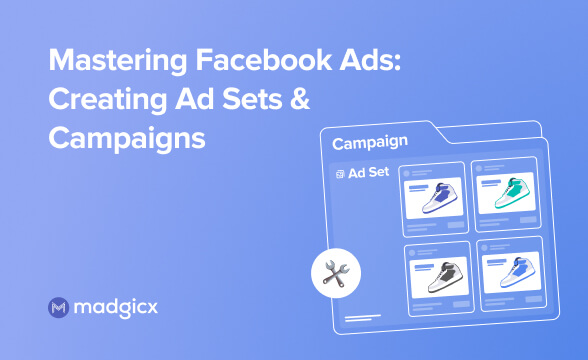Facebook CBO is a machine-led, data-driven method of allocating budgets. While it can get some work off your back, it's not always the best choice.
In advertising, one thing is for sure. Budgets should be maximized to achieve an ad campaign’s goal with little to no loss. This means maximizing conversions at the lowest cost possible.
Scaling trending assets, cutting losses by pausing ineffective campaigns, and using budget optimization tactics are some of the most popular ways to reach your campaign objective without bleeding out dollars.
As an advertiser, what are the most effective tactics you swear by when creating and scaling your campaigns? Are you more of an ad-set budget optimization (ABO) or campaign budget optimization (CBO) type of person? Or do you use each depending on your marketing strategies?
This blog post will help you decide which one is better to use (and when) by telling you more about the newer of the two, Facebook CBO.
What is Facebook campaign budget optimization?
2019’s Q3 saw media buyers scramble over Facebook’s announcement that there will be a mandatory migration to Facebook Ads Manager’s new optimization method - CBO.
What happened though, was Facebook later retracted the upcoming mandatory switch to CBO.
Back to our main talk -- what’s the buzz around CBO?
Facebook CBO is a feature allowing Facebook’s algorithm to distribute your campaign budget across ad sets in real-time. It’s a part of Facebook’s Power 5 agenda that promotes leveraging their automated strategies.
By allowing the algorithm to allocate your budget based on campaign level optimization, your most effective ad sets get more chances to shine while your underperformers make way.
The goal of CBO is to generate a higher number of results. The results are based on your conversion objective for your campaign at the lowest cost per result.
Look at the ad sets below. You’ll notice that the ad set with the higher number of conversions has a higher amount spent.

Contrary to good ol’ ABO, where you can manually distribute the budget among ad sets and analysis is done at the ad-set level, CBO campaign performance is measured at the campaign level and requires less manual optimization.
Facebook CBO vs. ABO: which method is better?
Now that we mentioned CBO’s opposite, it’s time to compare them. They’re the only two available ways to optimize your budget when using Facebook ads. That’s why it's hard not to pit them against each other and find out which one can produce better results.
But first, allow me to define ABO. Before CBO came to life, Facebook advertisers worked their way around ad-set budget optimization (ABO). It gave them the freedom to set the individual daily or lifetime budget (and not minimum or maximum spend limits) for each ad set.
Here's an infographic on how ABO and CBO distribute the budget between ad sets:
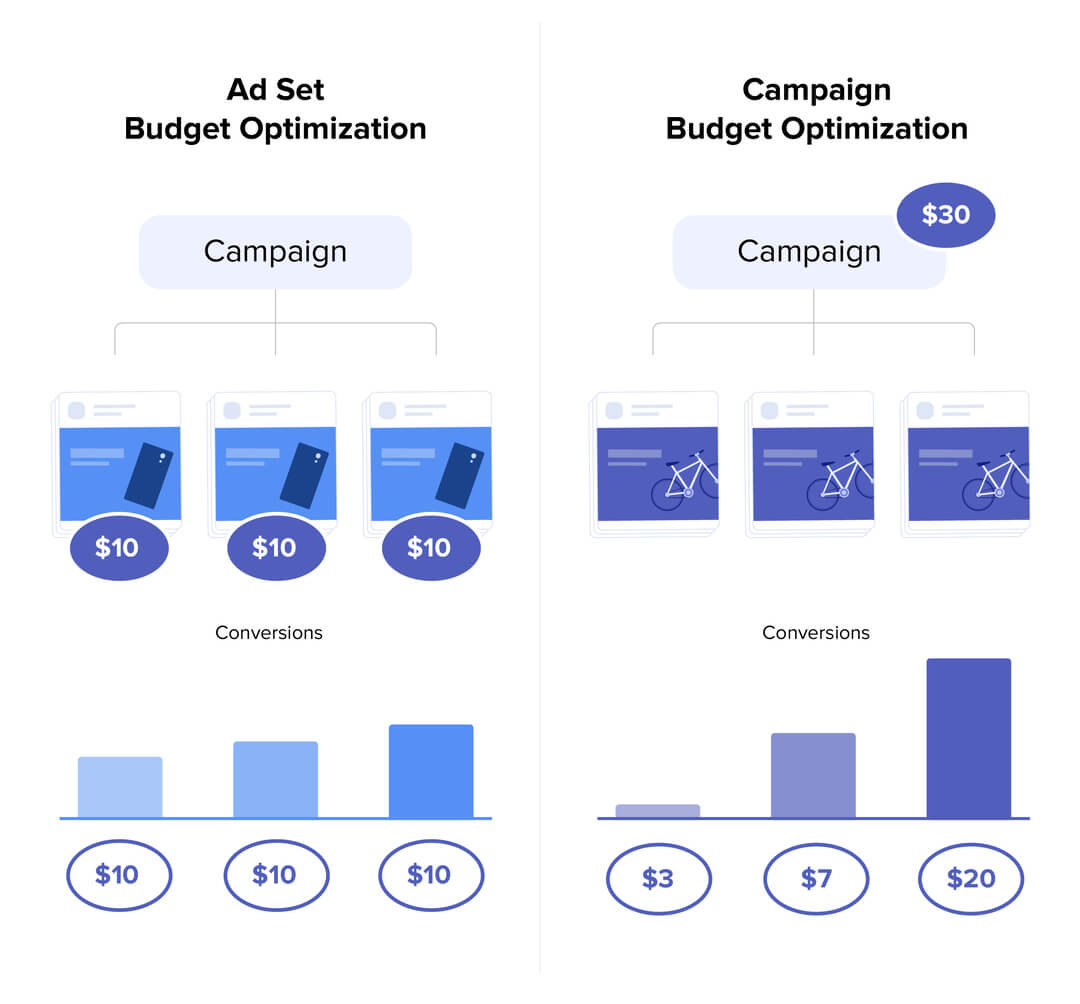
But is ABO better than CBO? Some would say yes while others would disagree.
To be honest, I don’t think they’re comparable. They both have cases wherein one of them is the better candidate based on your campaign setup.
If you want more flexibility and control over your budget and delivery, then ABO is much better for you. But if you want to lessen the manual work and allow AI to allocate your campaign budget for you, CBO’s there.
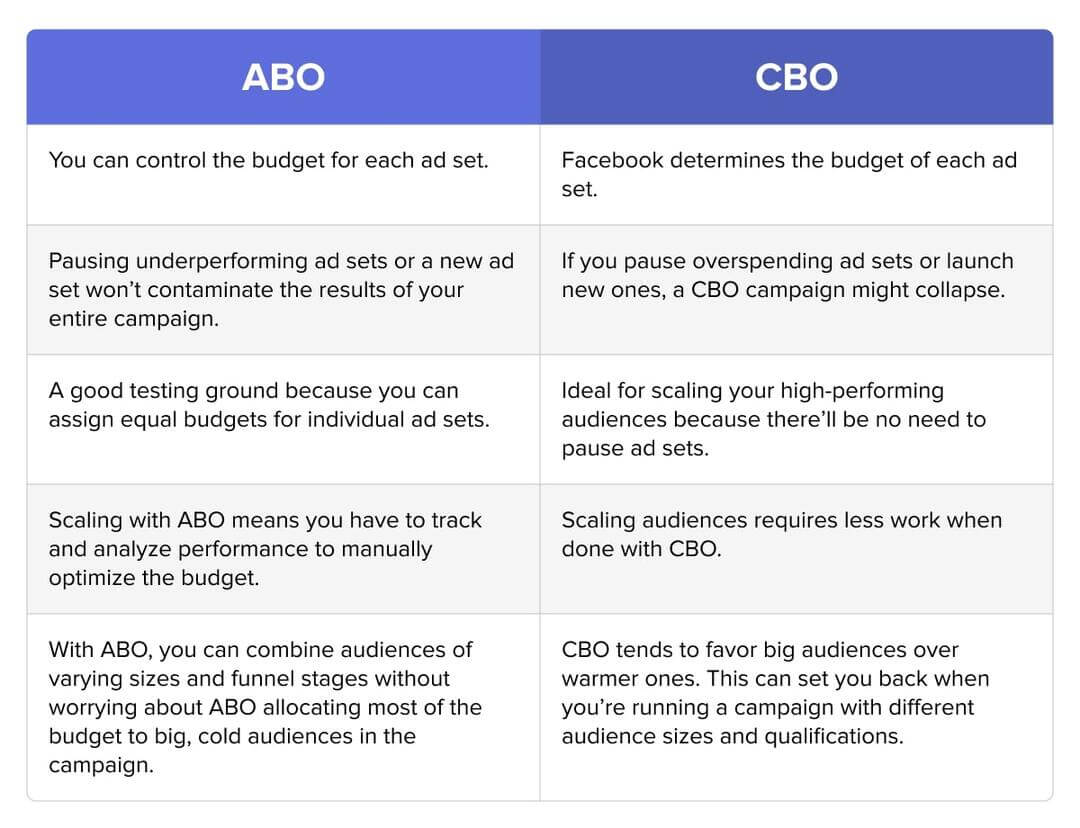
2 use cases for Facebook CBO campaigns
1. Scaling high-performing acquisition audiences
CBO’s decisions on distributing budgets among ad sets are backed by the data you provide. When you have audiences you want to scale, it’s better to do it with CBO.
Why?
You don’t have to be hands-on with tracking your ad sets’ performance accurately and budget allocation becomes the machine’s task.
Aside from telling Facebook who to target to help it look for the best opportunities for you to scale, you also benefit from the algorithm’s ability to assess what works best for your campaign.
This guides you to make data-driven decisions when distributing budgets across your ad sets.
Having about four to six different ad sets when scaling your audiences is good since it’s recommended by Facebook itself. Too many ad sets will make it difficult for the algorithm to generate results within a reasonable time frame.
Here are three interest-based audiences I’d like to duplicate and scale using CBO. I’ll hover over the first audience and click "Duplicate." Select "New Campaign," toggle Facebook’s Campaign Budget Optimization feature on, and set my campaign budget.
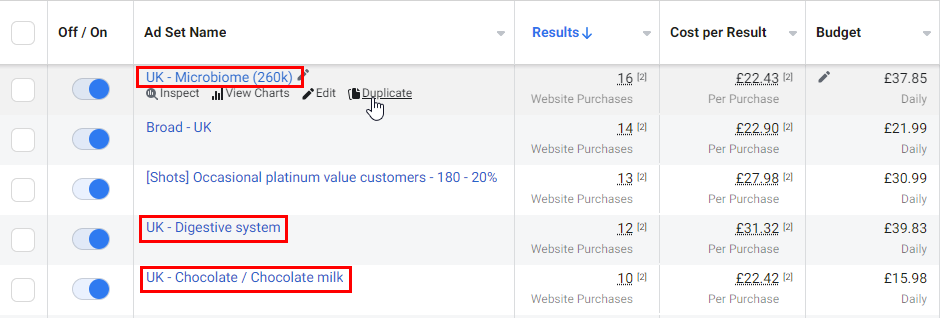
After that, I’ll hover over the other two ad sets and duplicate them into the same campaign. I'll select "Existing campaign" and choose my CBO campaign from the list.
Pro Tip: In duplicating audiences into a CBO campaign for scaling, you risk audience overlap. This means you could be bidding against your other ads in the auction.
What I’ll do when scaling interests is to turn on Detailed Targeting Expansion in the ad set level. This increases my potential reach and allows the algorithm to explore bigger areas of opportunity.
To turn on Detailed Targeting Expansion, head over to the ad set level. Then, click on "Edit" and make sure to check the box for Detailed Targeting Expansion.

Another case that risks audience overlap is when you’re targeting lookalike audiences (LLAs) in a CBO campaign. To mitigate this, you should input larger lookalike percentages for your LLAs when duplicating them.
2. Testing new audiences
When it comes to testing, ABO’s long been the go-to. But some advertisers prefer to use CBO for testing and let Facebook handle optimization for them.
Using CBO, you can test audiences of similar sizes and funnel stages (acquisition prospecting and re-engagement, retargeting, and retention). That can help you find the most promising audiences after analyzing campaign results.
The algorithm will feed the most budget to the audience it sees as the most likely to convert. That should show you which audience has the most potential.
Once you’ve got your winner, it’s time to scale.
What is the ideal number of ad sets you should test? Facebook suggests you stay around four to six ad sets. This lets the algorithm give you insights quicker because fewer ad sets need the budget.
The best practice for ad set budgeting with CBO would be ⅓ of your average cost per result. For instance, your average cost per result is $30, and you have four audiences you want to test.

In this case, you should set $10 as the minimum daily spend per ad set. Meaning, your total campaign budget should be at least $40.

To set the minimum daily budget, head over to the ad set level > “Budget & Schedule” > click on “Show More Options” > click on “Edit” > check the “Ad Set Spend Limits” box.

After about seven days or once you find your clear winner(s), you can remove the daily minimum budget and let CBO do its job.
Moreover, you can scale your CBO campaign’s budget by 20% if you want to play it safe. You can also scale by 1x or 2x your average cost per result if you wish to scale more aggressively.
Alternatively, once your CBO experiment is done, you can duplicate your winning audiences into another campaign and scale them manually with ABO. However, that method is only recommended for relatively large audiences (1M+) due to the risk of audience overlap.
Tips for running efficient CBO Facebook campaigns
Here are tips you can keep in your advertising handbook to make your CBO Facebook campaign a success.
1. Group audiences by size
CBO prefers audiences that have more people in them because of the abundance of data.
When you’re creating a CBO campaign with three different audiences that differ greatly in size, you should expect the algorithm to pour the budget into the bigger audiences within that campaign.
So when you’re setting up your campaigns, make sure to put a large or broad audience into the campaign with audiences of the same size to give them all a fair shot at delivery.
Naturally, the same thing goes for small audiences.
Pro Tip: If you want to scale interests with varying audience sizes, turning on Detailed Targeting Expansion is a good way to increase potential reach and essentially make up for the difference in size.
2. Set up campaigns based on funnel stages
The accurate results you want won’t come in if you group your top-of-the-funnel (TOFU), middle-of-the-funnel (MOFU), and bottom-of-the-funnel (BOFU) audiences in a single CBO campaign.
To be more specific, don’t lump a cold LLA of your website visitors from the last 365 days with custom audiences of people who bought from you in the last 30 days in the same lead generation campaign.
Will Facebook give more budget to the more qualified audience at this rate? Not really, since it tends to favor bigger audiences, which in this case is your prospecting audience.
It could be a waste of ad spend because that budget could’ve gone to the 30-day purchaser audience, which could’ve been more beneficial for your business.
Lastly, combining audiences from different funnel stages in the same campaign isn’t a smart move. They should have different budgets, ads, and KPIs even when you’re setting the budget on the ad set level.
3. Set the right budget
When scaling your best performers, your overall campaign budget should be based on the current budgets your ad sets are getting. Depending on performance, you can either maintain the budget or scale by 1x, 2x, or 3x your ad sets’ average cost per result.
Why is the minimum scaling amount 1x your average cost per result? Let’s say your cost per result averages at $10. If you scale by $3 to $5, you might not gain more conversions but spend more to get the same number of purchases.
You can also scale more aggressively, but it'd be a good starting point to scale by at least 1x your average cost per result.
If you want to go higher, make sure not to go too crazy. The last thing you want is to shock Facebook’s algorithm with significant changes that cause it to recalibrate. Even when your audiences perform well, scaling by 10x at once isn’t always recommended.
4. Only scale your trending assets
When you find an audience you want to scale, you should also consider if that audience is performing consistently, generating profits, and is showing positive momentum.
That audience could be showing good performance trends in the last 30 days, but you should also look at smaller time windows to verify that the performance is consistent and you won’t be spending money to ride a negative momentum.
Recommended Reading: 6 Proven Treatment Methods for Ad Fatigue on Facebook.
5. Leave your ad sets alone
Utilizing CBO means leaving ad sets in Facebook’s hands. That doesn’t mean giving the platform free money by letting underperforming ad sets bleed ad dollars out. It means letting the algorithm optimize based on its own analysis of your ad set’s performance.
When you see an ad set in a CBO campaign performing below your expectations, I know turning it off is the first thing you want to do. However, in CBO campaigns, you should always make decisions based on the data you see at the campaign level -- look at the total number and average cost per result.
If you modify your ad sets while your CBO campaign is already running, it’ll go back to the learning phase to recalibrate. Recalibration usually causes CBO campaigns to show significant performance drops as it has to relearn everything because a variable has changed.
Upgrade to account budget optimization
While Facebook offers campaign-level budget optimization, Madgicx’s Autonomous Budget Optimizer has something better: it optimizes at the account level.
How does it work?
With Madgicx’s Autonomous Budget Optimizer, you can leave the job of real-time scaling and downscaling to AI, which is backed by expert media-buying knowledge. How your account will spend, upscale, and downscale campaigns, ad sets, and ads is based on the strategies you set up.
Simply set the KPIs most valuable to your business, and make data-driven decisions with machine learning.

Ready to run your CBO Facebook ad campaign?
I hope so! Now that you know a lot more about CBO, its features, and how it reacts to your campaign structure and audiences, it’s time you give emphasis on how you group your audiences in each campaign, CBO or ABO.
You might have hundreds of high-performing audiences, but if you don’t know how to properly group them when you want to scale, you wouldn't be able to utilize their profitability.
So when you see a good audience that is scalable, take it and make sure to utilize the features of CBO.
When you set up your CBO Facebook ads correctly and group similar audiences, you can generate the results you want, get more insights into your top audiences, and hit your ROAS goal.
Just remember audience size, type, and qualification matter in CBO. So make sure you don’t mix audiences that are too different in these criteria.
Forget ABO and CBO. Madgicx can protect your budget and optimize performance across all your assets 24/7.
Natalie values content writing as a way to inform and ask people questions. To her, posing questions spark her own and others' curiosity and encourage learning.



